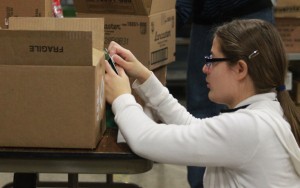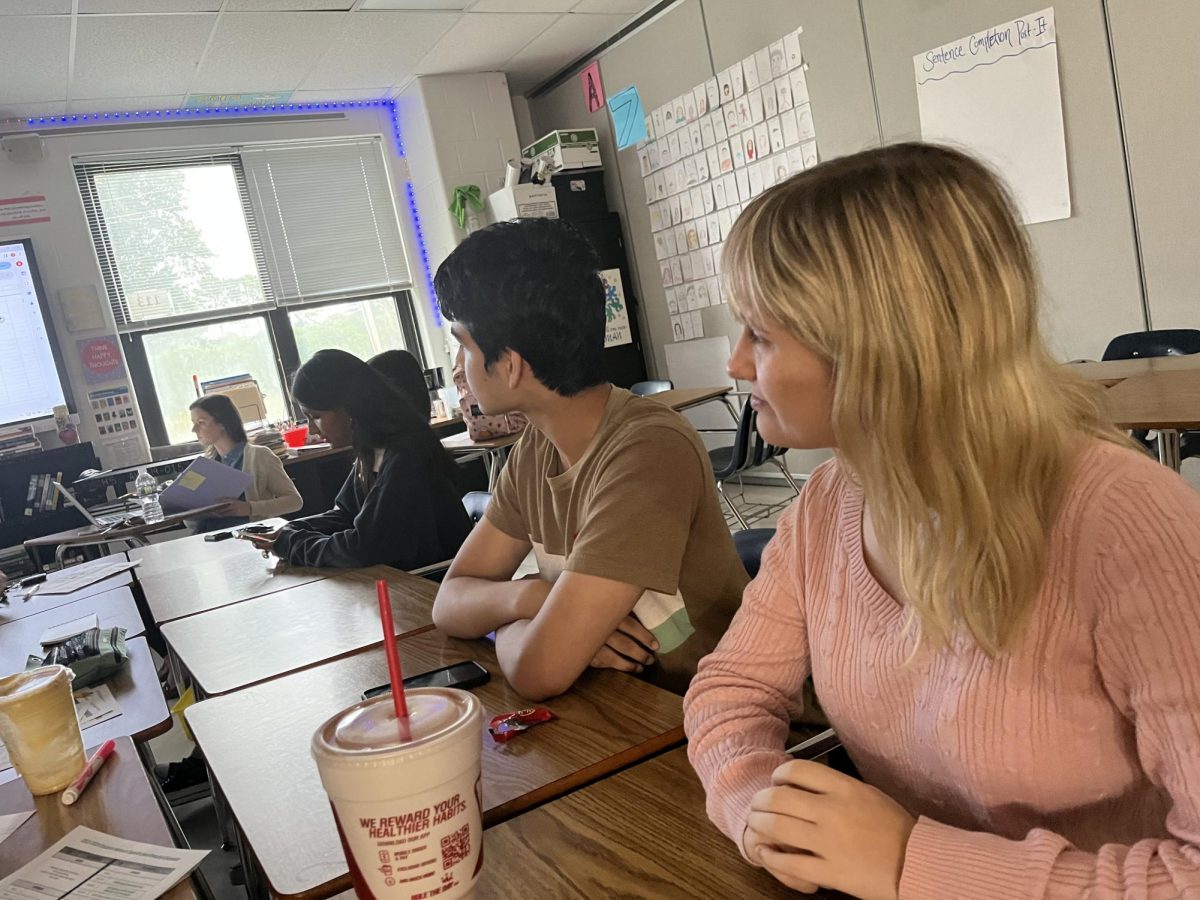
practicing job skills.
She follows the paraprofessionals (paras) onto the bus, talking about where she’d like to work some day in the future.
“I was thinking about the movie theater,” sophomore Ali Butler says. “I might work there sometime for a job. I might be a ticket person.”
She ponders working at Walmart or Best Buy or Target, stocking items or organizing merchandise.
“I like to organize, so it’s not too messy,” Ali says. “I like to be neat.”
She’s on her way to work today, not at any of the places she named, but Gordmans. She,
along with other students, goes on Career-Based Instruction (CBI) trips each Thursday to build skills she will use in the future. Many students in regular education classes assume the buses are for a fun field trip, but these students know better. They are going to work various jobs that will help them in their future careers. These jobs range anywhere from checking expiration dates on food items to hanging clothes.
“I like to stock clothes,” Ali says.
Today, Ali isn’t hanging shirts, though. She follows the paras accompanying her group to the back of Gordmans, entering the Associates Only door. In the cement room, her para explains what the group will be working on today, labeling items. Ali spends an hour sticking prices on products. She peels the labels from the boxes and carefully places them on the packages where they can easily be seen and scanned.
“I like it,” Ali says as she sticks a price label on a bag of Lemonheads. She shows the bag to one of the paras, who nods and moves on to help another student.
LEARNING LIFE SKILLS
When students in regular education classes do not have a connection to the special services system, they often do not understand what having educational disabilities means. While some identify students with special needs by their physical differences, Assistant Principal Katie Greer emphasizes that the spectrum of need has a wide range of mild and severe cases.
“If you thought of special education, typically a student would think of somebody in a wheelchair or somebody with a physical disability of some sort,” Greer said, “but there are students all across the spectrum. We have students that are in honors and AP classes that fall under the special education umbrella. There’s just a variety of reasons and identifications for special education, not just what one might typically think of as ‘those kids.’”
Just like students in regular education courses, Ali receives a well-rounded education. Her favorite class is keyboarding because she believes it is important to know how to type.
“I’m very good at keyboarding,” Ali said. “I have a Facebook, and I’m typing. I type [my friend] Kendyl all the time.”
At FHN, students with educational disabilities are integrated into regular education classrooms as much as possible. This idea of inclusion is unique because many schools still don’t integrate their students in special services with their students in regular education classes. According to Lisa Pentecost who has also worked in the Special School District, inclusion is the best learning environment.
“In the Francis Howell School District, all students…[are] part of the same students,” Pentecost said. “I’m paid by the same people who pay the English teacher down the hallway, and I’m part of that group and that family. Having students be a part of that family and having their teachers be part of that family, they excel. They can reach higher goals…. By keeping them separate, it just keeps them down.”
According to Pentecost, some families move to the District because they are aware that FHSD gives all of its students equal treatment.
“They want the school to be responsible for a student with a disability as much as they are for a student who’s an honors student,” Pentecost said. “And they should be. They definitely should be.”
For most core classes, these students learn with special services teachers like Pentecost, an Essential Skills teacher. These classes differ a bit from regular education classes because they don’t have step-by-step curriculums, and the students do not use textbooks. However, like any class, the ultimate goal is to prepare students for life after high school.
PREPARING FOR WORK
Other misconceptions that paras and teachers have heard include whether students in special services can make a living by working. As seen from the CBI trips, these students are capable of holding a job because they can learn jobs skills just like everyone else.
“They can work; they can learn; they can help out,” para Brian Schene said. “Just because you saw them one time have a meltdown, doesn’t mean that’s what they are…. they just have a little bit of something they’re dealing with and I don’t even like saying dealing with but they’re handling it. Most of them are handling it. They’re getting a lot more today than they ever did before. They’ve got so many more resources to help them. There’s so much more to these individuals that people don’t know. [Others] just need to take the time to kind of find out.”
Life Skills teacher Pentecost works on soft skills with her students to help them prepare for jobs. Soft skills are personal attributes that enable someone to interact effectively and harmoniously with other people. !ese skills include things like communication, decision making and teamwork. These things come more easily to students in regular education classes, but every person must work on soft skills in order to be appealing to employers.
“All of our work is focused on helping the student to transition from high school to adult life,” Pentecost said. “That’s kind of everybody’s goal, I mean that’s what [everyone’s] teachers are working on, the same thing, but we may not be working on social studies very much in order to work on being able to go to a job.”
MAKING A DIFFERENCE
In the end, the special services staff loves seeing the students learn and improve each day. Head Principal Andy Downs oversaw special services for four years before stepping into the head principal position. Like everyone else in the department, Downs loves watching the students grow. The most important thing about students in special services, according to Downs, is to realize that they are great people with great strengths.
“I think that sometimes we define intelligence and ability too narrowly, and that you will find that there is great intelligence and ability in so many different arenas,” Downs said. “Ranging from really strong academic ability to extremely strong social abilities, there’s just a wide spectrum of wonderful strengths that you find in our students in our special ed program.”
Paras like Schene help students get from class to class and understand the material. They love seeing the students improve and like knowing that they are making an impact.
“I really love to see when students make progress,” Schene said. “When you see a student start to make the progress, and they start to get it and understand it–and they become more independent, and they start doing things on their own without you having to even say something–whenever you see that, that just makes you kind of cheer inside.”
Para Rita Brannan, who helps students who cannot communicate verbally with their machines, enjoys seeing each student’s personality.
“When they do what they’re supposed to do it’s really great, but when they do something that’s unexpected, that makes you laugh or just makes you smile, [that’s the best part],” Brannan said. “It’s the unexpected, funny things that these kids do.”






![Ninja Christmas [Comic]](https://FHNtoday.com/wp-content/uploads/2024/12/Ninga-Christmas-Comic-1200x898.jpeg)







